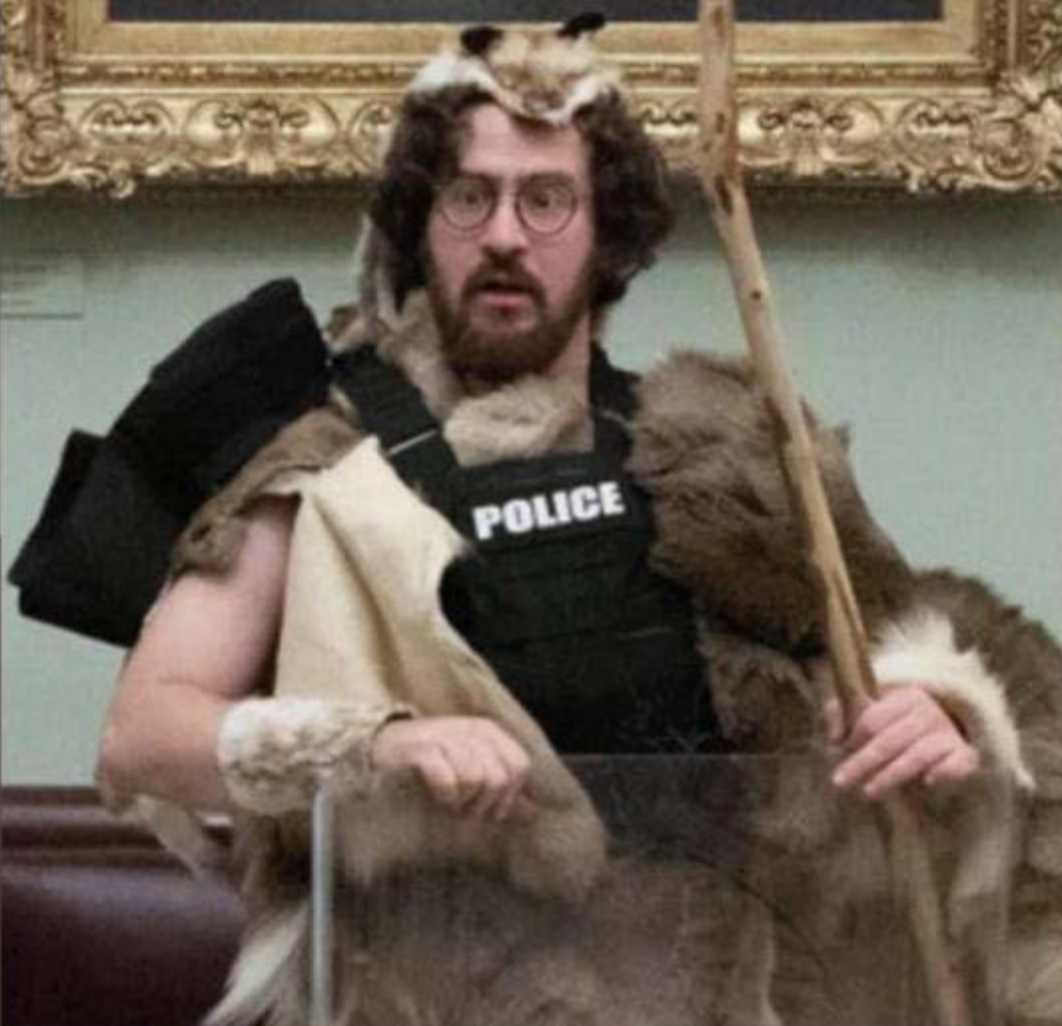The Video Authentication Challenge: Aaron Mostofsky
As January 6 trials move towards sentencing, the government has started submitting motions in limine, which are basically arguments before the trial about the scope of what will be permitted at trial. DOJ seems to have standard motions to prevent people from arguing Trump made them riot and attempting to nullify the jury.
But a motion submitted in Aaron Mostofsky’s case is worth reading in detail for the way it deals with a difficult aspect of the January 6 investigation: how to authenticate all the video that will be used against a defendant at trial. Probably because Mostofsky (whose father is a judge) dressed in pelts and donned a police vest, there’s a lot of video evidence against him. But that’s one thing they plan to use to authenticate the video against him: because so many people (including two journalists) caught him as he moved through the Capitol.
The distinctive characteristics of the defendant’s attire, combined with the distinctive characteristics of other rioters depicted captured on USCP and MPD footage, will further help support authentication of these exhibits.
Mostofsky also traveled much the same path as Kevin Seefried, whose Confederate flag similarly made him a common subject of video (but whom it doesn’t name).
The government wants to use video from cops, from other rioters, from journalists, and from one or two innocent bystanders against Mostofsky:
- US Capitol Police Surveillance video
- Metropolitan Police Department bodyworn camera video (remember that Capitol Police were not outfitted with cameras on Jan 6)
- Publicly posted video from other rioters, including
- A YouTube posted to the Buggs Media Network showing his approach
- Videos posted to Parler:
- Parler video time-stamped at 12:56 p.m, marked near Capitol
- Parler video time-stamped 2:15 p.m marked inside the Capitol (note: because the person who filmed this was among the first in the Capitol, DOJ must have a good idea of who filmed this, but it doesn’t disclose that nor source it from that person)
- Parler video time-stamped at 2:22 p.m., marked inside the Capitol
- A video recorded by a person using the moniker “@statuscoup” live-streamed by JeffMAC Press (replicated in an HBO documentary) showing his approach
- John Sullivan’s video; the filing notes that it is available on YouTube, but at least one arrest affidavit describes the FBI receiving a copy from an anonymous source on January 8; DOJ relies on Sullivan’s video to show what Mostofsky did under the scaffolding outside
- HuffPo reporter Igor Bobic’s video of the rioters chasing Officer Goodman
- An interview with Mostofsky with a NY Post reporter
- A video captured by a person present at the riot and uploaded to TikTok and Twitter
- A video, which the filing calls the “upstairs video,” filmed by a person inside the Capitol immediately before it was breached; the person was one or more floors above the Senate Wing Door
The government plans to have a Capitol Police and an MPD witness authenticate those videos (it sounds like, for defendants captured in multiple scenes in MPD video, they’ll need multiple witnesses). As for the video from other sources, it plans to authenticate it by correlating it with the surveillance video:
The government also intends to offer numerous video clips from sources other than USCP and MPD. Some of these were taken from reporters who were present in the Capitol that day. Others were taken by the defendant’s fellow rioters or other members of the crowd. Many were obtained through open-source means and are publicly available. For these videos, as described further below, the government will establish authenticity by asking the jury to compare them with other, authenticated exhibits: USCP and MPD footage.
The filing notes that it will draw on otherwise inadmissible evidence, such as Parler’s labels for where it took videos, to help authenticate the videos posted as the site.
In deciding preliminary questions about the admissibility of these videos, “[t]he court is not bound by evidence rules, except those on privilege.” Fed. R. Evid. 104(a). In other words, the government may rely upon otherwise inadmissible evidence in establishing the authenticity of the video evidence described in this motion. See, e.g., United States v. White, 116 F.3d 903, 914 (D.C. Cir. 1997).1
1 This matters, for instance, in analyzing Parler videos publicly available through ProPublica, and discussed infra at 8-9 and 13-17. The government’s argument for authentication of these videos relies in part on hearsay statements by ProPublica which the government does not intend to elicit at trial. Similarly, the government bases the John Sullivan video, discussed infra at 11-12, in part on portions that are confirmed by USCP footage elsewhere in the building but are unrelated to this defendant.
None of this relies on calling the known defendant-source of video (John Sullivan) or the video from other rioters most of whose identities DOJ must know. Nor does the “upstairs video,” which appears to have been filmed from one of the people legally present in the Capitol as it was stormed.
DOJ only mentions the prosecutions of Jacob Chansley and Sullivan; it does not name Kevin Seefried or Doug Jensen, whose presence in videos DOJ also uses to correlate the videos.
As I said above, both because he was so distinctively dressed and because much of the available video is so clear, Mostofsky is among the easiest defendants to do this with. This process will get more difficult as DOJ moves towards prosecuting people for things that happened where no police footage was available to correlate a person’s actions.

